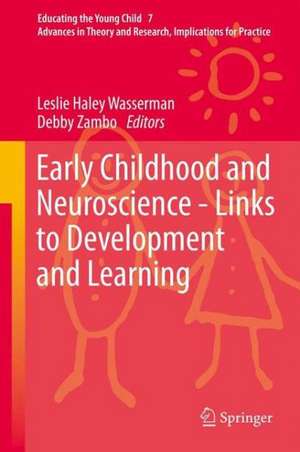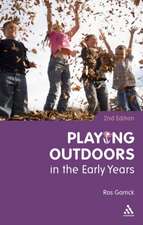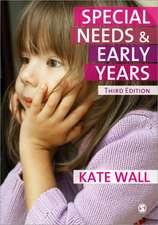Early Childhood and Neuroscience - Links to Development and Learning: Educating the Young Child, cartea 7
Editat de Leslie Haley Wasserman, Debby Zamboen Limba Engleză Hardback – 18 iun 2013
| Toate formatele și edițiile | Preț | Express |
|---|---|---|
| Paperback (1) | 990.57 lei 6-8 săpt. | |
| SPRINGER NETHERLANDS – 15 iul 2015 | 990.57 lei 6-8 săpt. | |
| Hardback (1) | 996.57 lei 6-8 săpt. | |
| SPRINGER NETHERLANDS – 18 iun 2013 | 996.57 lei 6-8 săpt. |
Din seria Educating the Young Child
- 18%
 Preț: 946.24 lei
Preț: 946.24 lei - 15%
 Preț: 467.46 lei
Preț: 467.46 lei - 15%
 Preț: 647.92 lei
Preț: 647.92 lei - 15%
 Preț: 700.75 lei
Preț: 700.75 lei - 18%
 Preț: 898.75 lei
Preț: 898.75 lei - 18%
 Preț: 783.20 lei
Preț: 783.20 lei - 18%
 Preț: 1005.43 lei
Preț: 1005.43 lei - 18%
 Preț: 888.49 lei
Preț: 888.49 lei - 18%
 Preț: 1003.07 lei
Preț: 1003.07 lei - 20%
 Preț: 563.08 lei
Preț: 563.08 lei - 24%
 Preț: 814.75 lei
Preț: 814.75 lei - 15%
 Preț: 639.25 lei
Preț: 639.25 lei - 15%
 Preț: 635.47 lei
Preț: 635.47 lei - 15%
 Preț: 636.80 lei
Preț: 636.80 lei - 15%
 Preț: 635.65 lei
Preț: 635.65 lei - 20%
 Preț: 567.32 lei
Preț: 567.32 lei - 15%
 Preț: 644.63 lei
Preț: 644.63 lei - 20%
 Preț: 563.40 lei
Preț: 563.40 lei
Preț: 996.57 lei
Preț vechi: 1215.32 lei
-18% Nou
Puncte Express: 1495
Preț estimativ în valută:
190.69€ • 199.63$ • 157.79£
190.69€ • 199.63$ • 157.79£
Carte tipărită la comandă
Livrare economică 05-19 aprilie
Preluare comenzi: 021 569.72.76
Specificații
ISBN-13: 9789400766709
ISBN-10: 940076670X
Pagini: 200
Ilustrații: XII, 220 p.
Dimensiuni: 155 x 235 x 20 mm
Greutate: 0.5 kg
Ediția:2013
Editura: SPRINGER NETHERLANDS
Colecția Springer
Seria Educating the Young Child
Locul publicării:Dordrecht, Netherlands
ISBN-10: 940076670X
Pagini: 200
Ilustrații: XII, 220 p.
Dimensiuni: 155 x 235 x 20 mm
Greutate: 0.5 kg
Ediția:2013
Editura: SPRINGER NETHERLANDS
Colecția Springer
Seria Educating the Young Child
Locul publicării:Dordrecht, Netherlands
Public țintă
ResearchCuprins
Acknowledgements.- Preface; Layne Kalbfleisch.- Introduction; Leslie Haley Wasserman and Debby Zambo.- 1. The Practical and Ethical Concerns of Using Neuroscience to Teach Young Children and Help them Self-Regulate; Debby Zambo.- 2. Neuroscience: The Genesis of Our Individual Brain Strengths; Diane Connell and Jena VanStelten.- 3. Reading and the Young Brain; Nancy Frey and Douglas Fisher.- 4. Brain Development in Early Childhood: A Critical Analysis; Valeri Farmer-Dougan and Larry Alferink.- 5. Addressing the Affective Domain: What Neuroscience says about Social/Emotional Development in Early Childhood; William A. Mosier.- 6. Early Literacy Trends for Children Identified as At-Risk for School Failure: Are They Consistent with Contemporary Neuroscience and Learning Theory?; Rae Ann Hirsh.- 7. Brain Differences in Children with Autism and the Subsequent Impact this has on Learning; Diane Branson.- 8. The Twice Exceptional Young Learner; Leslie Haley Wasserman.- 9. Making a Case for Early Intervention: The Role of Developmental Neuroscience; Niamh Stack.- 10. Effective Strategies to Help Teachers Learn about Brain Development; Billie Enz and Jill Stamm.- 11. Metaphors of Developmental Process for Brain-Savvy Teachers; George Hruby.- Closing Thoughts: Remaining Optimistic, Cautious and Active; Debby Zambo and Leslie Haley Wasserman.
Textul de pe ultima copertă
Information from neuroscience is growing and being properly used, and misused wich makes it imperative that educators receive accurate and practical information. This book provides the accurate and practical information educators (pre-service and in-service) and caregivers serving children birth through age 8 need to know. This volume takes a practical and cautionary stance. It reminds educators to consider the ethical implications of neuroscience when it is applied to education, reviews current findings from neuroscience and reveals the dangers of oversimplification and inappropriate extensions of neuroscience into curricula. It brings together a group of authors with varied expertise writing on an array of inter-related educational topics that will help educators use neuroscience to understand and address the cognitive, emotional, social, and behavioral needs of all young children, including those with exceptionalities. They believe neuroscience can be insightful and useful to educators if applied ethically and with care. The book offers strategies educators and caregivers can use to affect children today and the adults they can become.
Caracteristici
Provides a greater understanding of how the brain develops, functions and learns Shows how the understanding of the brain can be used to educate young children Gives insight into the importance of both heredity and the environment for young brains Provides specific strategies and approaches drawn from neuroscience that create effective learning environments Includes supplementary material: sn.pub/extras















